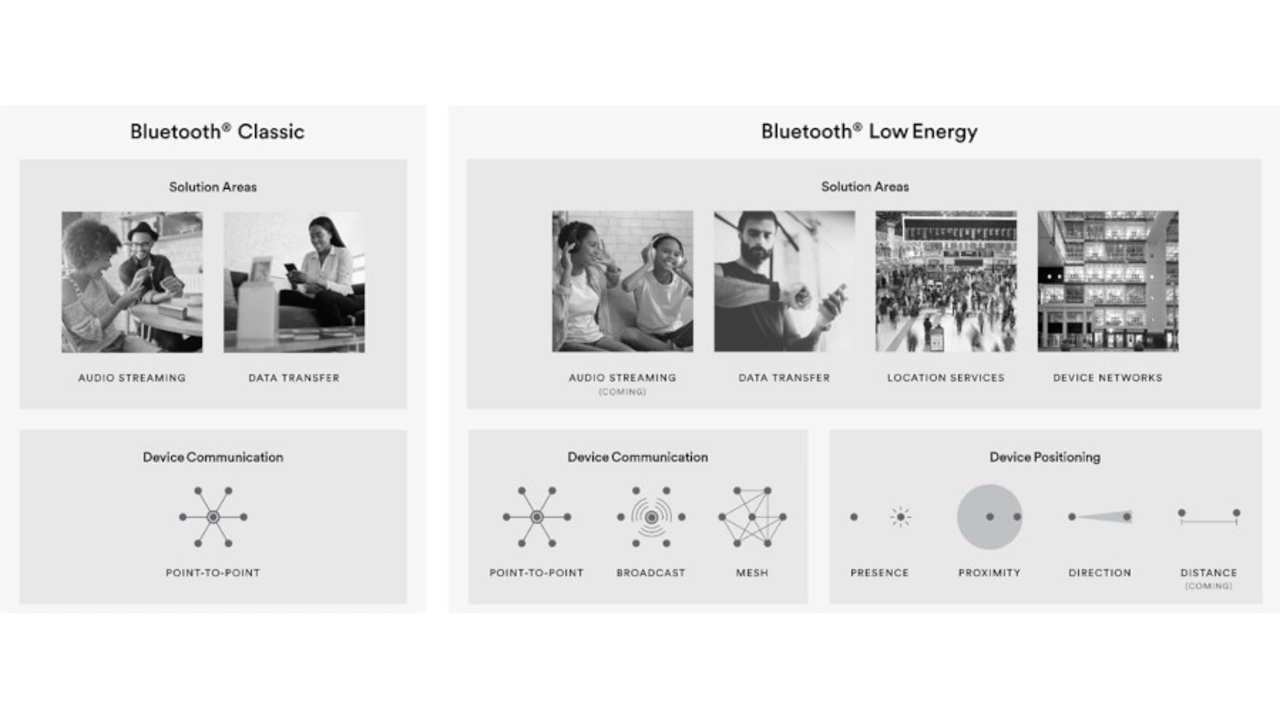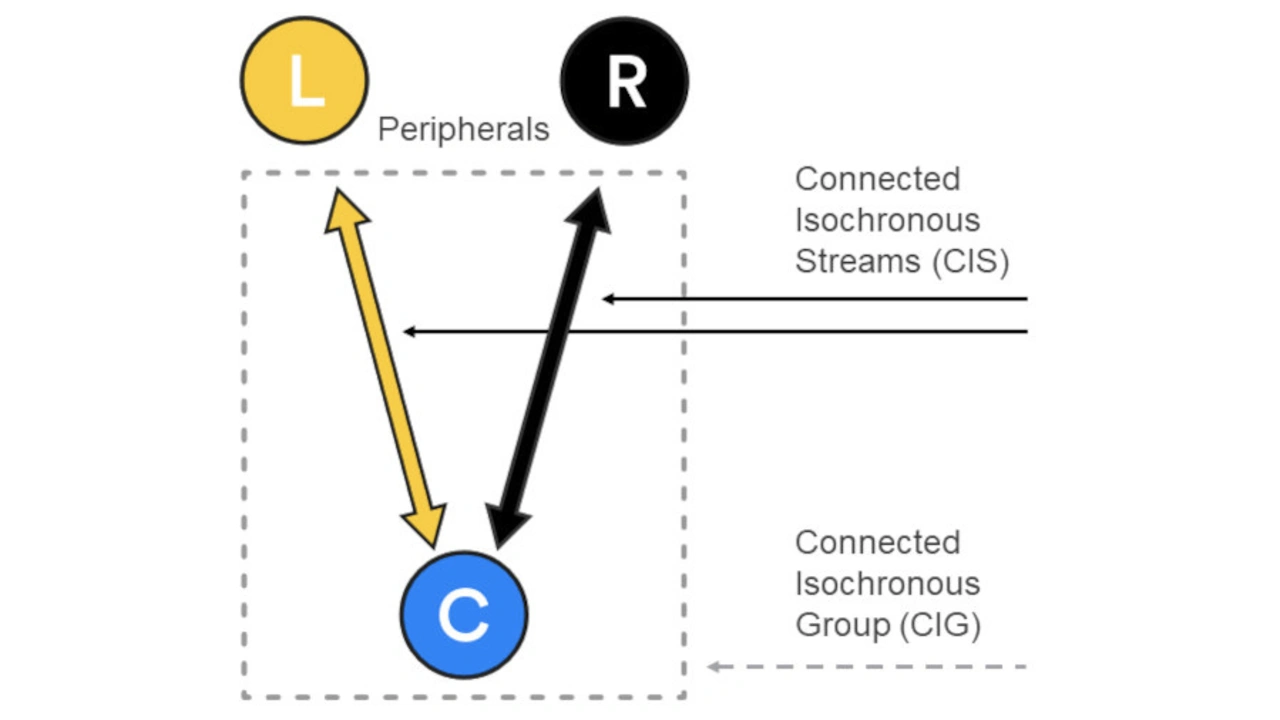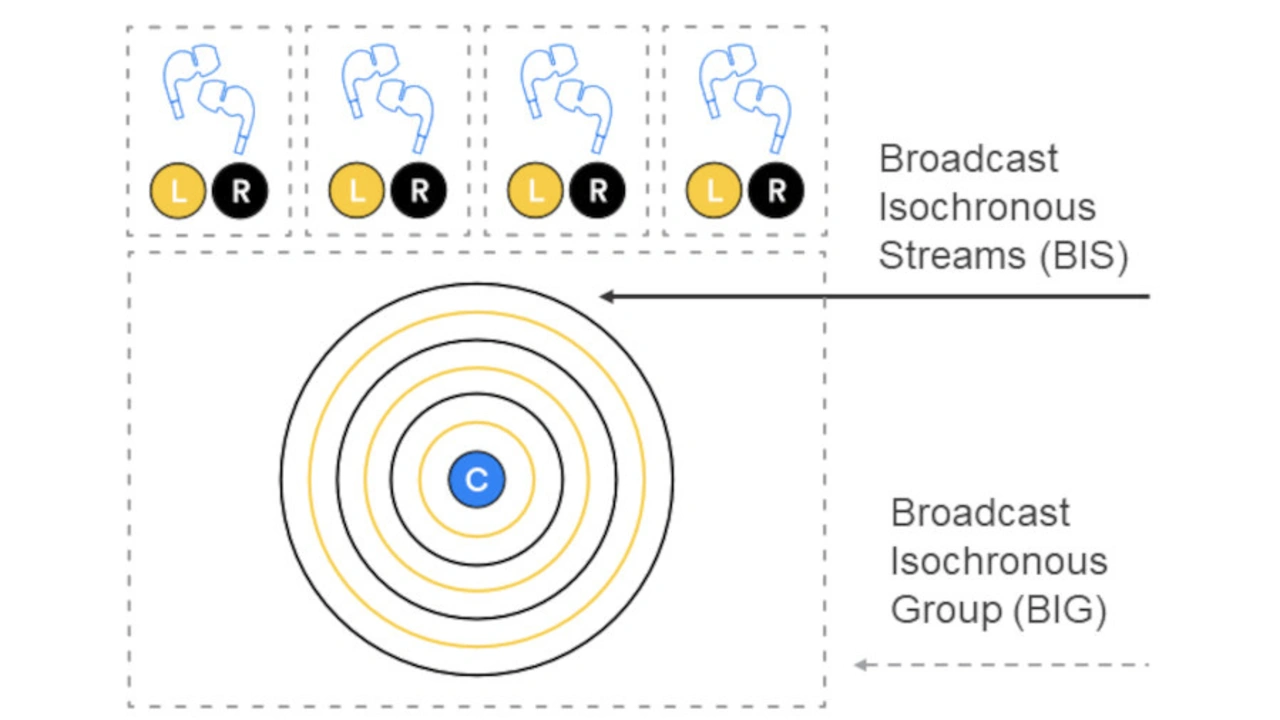Wireless Audio Connectivity
Bluetooth LE Audio
Based on Bluetooth Low Energy (Bluetooth LE) Bluetooth LE Audio has been created to provide better audio quality for listeners and to allow new audio product topologies and new use cases.
Bluetooth technology today is very different to the original technology released just over twenty years ago and such is its versatility, it’s useful to think of it as a toolkit for communication and positioning rather than as a single, static entity. It takes two distinct forms; the older of the two called Bluetooth Classic and the newer, Bluetooth Low Technology (LE).
Bluetooth Classic supports point to point communication topologies for data transfer and audio streaming and audio is one of its most successful and widespread applications.
Bluetooth Low Energy can be used for both point to point communication and for the broadcasting of data in a connectionless way, from one transmitting device to an unlimited number of receiving devices. It supports the creation of location-based services where presence can be detected and proximity to points of interest determined. Accurate direction-finding using the angle of arrival (AoA) and angle of departure (AoD) methods support applications like asset tracking and indoor navigation and a high accuracy distance measurement (HADM) specification is in development. Device networks containing potentially tens of thousands of devices in contexts such as smart buildings can be created, thanks to the Bluetooth mesh profile.

LE Audio is a more versatile audio technology based upon Bluetooth LE and it has been created to provide better audio quality for listeners and to allow new audio product topologies and new use cases to be supported.
Key Features of Bluetooth LE Audio
LE Audio allows audio streaming to be conducted in two different ways known as unicast audio and broadcast audio. In each case, a communication method known as isochronous data transfer is used. Isochronous data transfer is concerned with the communication of time-bound data. To appreciate this, consider headphones which use Bluetooth Classic. Such a device contains a single Bluetooth stack, physically installed adjacent to one of the two speakers in the headphones. Packets from the audio source device contain both left and right stereo data. On receiving a packet, this data is decoded and rendered in each speaker at the same time, with the two speakers connected by wires to the active electronics. However, LE Audio is designed to support audio streaming of different but related content to multiple completely independent devices. A pair of earbuds make for a simple example. Data for left stereo is delivered to the left earbud in one packet and then data is delivered to the right earbud in a different packet a little later. The use of isochronous communication means that the left and right audio data is rendered at the same time in each earbud and the listener hears perfect stereo audio.
Unicast audio uses Bluetooth LE ACL connections as the underlying transport. Communication channels called connected isochronous streams (CIS) are created over the connections, with each stream carrying distinct content such as left or right stereo data. Streams are grouped within an owning connected isochronous group (CIG) and the rendering of audio data from all streams within the same group is carried out at precisely the same time by each connected audio sink device.
Broadcast audio uses Bluetooth extended advertising and audio is transmitted in broadcast isochronous streams (BIS) which are members of a broadcast isochronous group. Broadcast audio communication is connectionless and the number of audio sinks which can receive broadcast audio streams is unlimited.


Both unicast and broadcast audio allow more than one person at a time to listen to the same audio source. A small group of friends can listen to the same music playing on one smartphone in their Bluetooth headphones. Any number of people can listen to public broadcasts from a TV using their headphones and earbuds in a bar or at the gym.
Furthermore, leveraging the LE Audio broadcast capability, Bluetooth Audio Sharing will be a new, global consumer service that will deliver enhanced listening experiences and audio accessibility. It is anticipated that public venues such as theatres, lecture halls, gyms, train stations, airports and bars will offer the Bluetooth Audio Sharing service, enabling people to listen to otherwise silent TVs and PA systems in their wireless headphones, earbuds and hearing aids.
See [1] for more information on the planned Bluetooth Audio Sharing service.
Streams and Contexts
Streams contain distinct audio content such as left and right stereo data. Other uses of streams are envisaged however, such as to contain distinct language versions of the same voice narration or announcement.
Streams have associated contexts which indicate the use case associated with the audio and include standard values such as “TV” and “EmergencyAlert”. Context values can be used in the filtering and selection of audio streams.
Imagine standing on a platform at the railway station listening to your music. If you’ve opted to, you will also here announcements regarding the arrival and departure of trains too.
Coordinated Sets
Some types of device are used in sets of more than one and actions need to be coordinated across all members of the set. You will typically want to change the volume in both your left and right earbuds for example. The concept of coordinated sets provides that capability, with devices able to be members of sets and control exercised over the set as a whole. Sets are identified by a Private Set Random Identifier and are secured with a Set Identity Resolving Key (SIRK). Concurrent access to the devices in a set is controlled through lock and rank concepts which ensure there are no race conditions or side-effects possible when more than one device tries to take control of a set.
Published Audio Capabilities
Devices have defined audio capabilities and preferences such as the codecs supported and various audio parameters such as supported sample rates. This information is stored in Bluetooth characteristics in the form of PAC records and other devices can discover the information and use it when establishing an audio stream.
Delegation and Assistance
Discovery of audio streams involves scanning, filtering and selection. Broadcast audio streams may require scanning to be performed for longer than for unicast streams and scanning is a relatively expensive operation in terms of the energy required. This can be an issue for smaller, power- constrained devices. Furthermore, some device types have very limited user interface capabilities, with nothing more than a button in some cases.
LE Audio allows scanning for a broadcast audio source to be delegated to another device which perhaps has a larger capacity battery and more suitable user interface. Smartphones, watches and remote controls are examples of devices to which scanning might be delegated by constrained devices like earbuds or hearing aids. When a suitable source has been discovered and selected by the user, its audio and timing parameters are passed to the original device(s) which can then establish the required broadcast isochronous streams, having expended minimal energy in the whole process.
Quality of Service
Audio Stream Endpoints (ASE) have quality of service (QoS) requirements which are indicated with reference to standard sets of parameters that are defined in the LE Audio specifications. The defined parameter sets specify different sample rates and therefore audio quality and provide differing levels of reliability and latency. Product designers choose QoS parameter sets according to the priorities for the product.
Security
Unicast audio may be secured using standard Bluetooth LE link security which requires devices to have been paired. Broadcast audio may either be completely public and unencrypted or may be secured using an associated broadcast code from which a security session key is derived. Access to a secure broadcast audio stream requires possession of the broadcast code which may be distributed over Bluetooth connections if devices have been previously paired or out of band (e.g. printed on tickets) if they have not. Coordinated sets are protected through the use of a Set Identity Resolution Key (SIRK) which must be possessed to prove membership of a set.
- Bluetooth LE Audio
- The Technical Components of LE Audio





